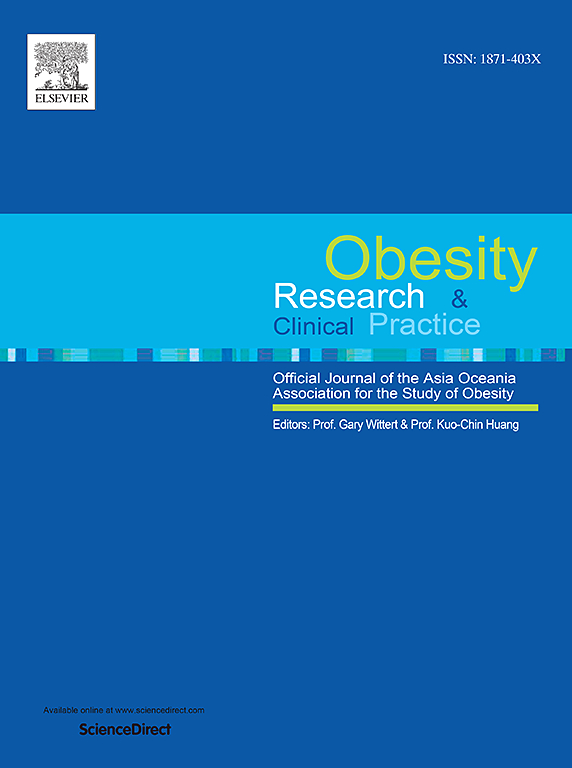Weight gain following an employer-based randomized trial evaluating the treatment of obesity with and without anti-obesity medication
IF 2.5
4区 医学
Q3 ENDOCRINOLOGY & METABOLISM
引用次数: 0
Abstract
Background
A pragmatic randomized controlled trial (RCT) reported superior weight loss when anti-obesity medications (AOMs) were added to a 1-year employer-based weight management program (WMP+Rx) compared to WMP alone. Evidence regarding sustainability of weight loss, upon trial completion, is lacking. This report aims to evaluate weight loss sustainability upon completion of the RCT.
Methods
This retrospective, observational report, analyzed data from subjects post-completion of the previous RCT. The main outcome was the mean change in body weight from baseline (end visit of the previous RCT) to 24 months.
Results
Of 199 subjects included in the RCT, 185 subjects who had pre-trial (prior to the previous RCT) and baseline weight (end visit of the previous RCT) were included in this report. Both groups; [WMP+Rx; 97 subjects, (52.4 %)] and [WMP; 88 subjects (47.6 %)] demonstrated an increase in mean body weight during the observational follow-up period; 5.2 % (95 % CI: 3.4 %, 7 %) and 6.3 % (95 % CI: 4.5 %, 8.1 %) for the WMP+Rx and 1.3 % (95 % CI: −0.6 %, 3.1 %) and 2.1 % (95 % CI: 0.3 %, 4 %) for the WMP, at 12 and 24 months, respectively. Higher percentages of individuals who gained of > 5 % of baseline weight was observed in the WMP+Rx vs WMP group; (47 %) vs (28 %) [odds ratio OR 3.16 (95 % CI: 1.19, 8.37), (P = 0.02)] and (51 %) vs (39 %) [OR 2.85 (95 %CI: 0.93,8.74), (P = 0.067)], at 12 and 24 months, respectively.
Conclusions
Weight loss achieved with WMP with or without AOMs was not maintained at 12 and 24 months. Chronic obesity management is needed for sustainable outcomes.
一项以雇主为基础的随机试验评估了使用和不使用抗肥胖药物治疗肥胖的效果。
背景:一项实用的随机对照试验(RCT)报道,在为期1年的雇主体重管理计划(WMP+Rx)中加入抗肥胖药物(AOMs)比单独使用WMP更能减轻体重。在试验完成后,缺乏关于体重减轻可持续性的证据。本报告旨在评估完成随机对照试验后体重减轻的可持续性。方法:本回顾性观察报告分析了前一项随机对照试验完成后受试者的数据。主要结果是体重从基线(前一次随机对照试验结束时)到24个月的平均变化。结果:在纳入RCT的199名受试者中,有185名受试者在试验前(前一次RCT)和基线体重(前一次RCT结束访问)被纳入本报告。两组;[买理财产品买+ Rx;97名受试者,(52.4 %)]和[WMP;88名受试者(47.6 %)在观察随访期间表现出平均体重增加;5.2 %(95 % CI: 3.4 % 7 %)和6.3 %(95 % CI: 4.5 %,8.1 %)为买理财产品买+ Rx和1.3 %(95 % CI: -0.6 %,3.1 %)和2.1 %(95 % CI: 0.3 % 4 %)买理财产品买,分别在12和24个月。与WMP组相比,WMP+Rx组增加基线体重> 5 %的个体百分比更高;(47 %)和(28 %)(优势比3.16(95 % CI: 1.19, 8.37), (0.02 P = )]和(51 %)和(39 %)(或2.85(95 % CI: 0.93, 8.74), (0.067 P = )],分别在12和24个月。结论:有或没有AOMs的WMP在12个月和24个月时无法维持体重减轻。为了取得可持续的结果,需要对慢性肥胖进行管理。
本文章由计算机程序翻译,如有差异,请以英文原文为准。
求助全文
约1分钟内获得全文
求助全文
来源期刊

Obesity research & clinical practice
医学-内分泌学与代谢
CiteScore
7.10
自引率
0.00%
发文量
80
审稿时长
49 days
期刊介绍:
The aim of Obesity Research & Clinical Practice (ORCP) is to publish high quality clinical and basic research relating to the epidemiology, mechanism, complications and treatment of obesity and the complication of obesity. Studies relating to the Asia Oceania region are particularly welcome, given the increasing burden of obesity in Asia Pacific, compounded by specific regional population-based and genetic issues, and the devastating personal and economic consequences. The journal aims to expose health care practitioners, clinical researchers, basic scientists, epidemiologists, and public health officials in the region to all areas of obesity research and practice. In addition to original research the ORCP publishes reviews, patient reports, short communications, and letters to the editor (including comments on published papers). The proceedings and abstracts of the Annual Meeting of the Asia Oceania Association for the Study of Obesity is published as a supplement each year.
 求助内容:
求助内容: 应助结果提醒方式:
应助结果提醒方式:


